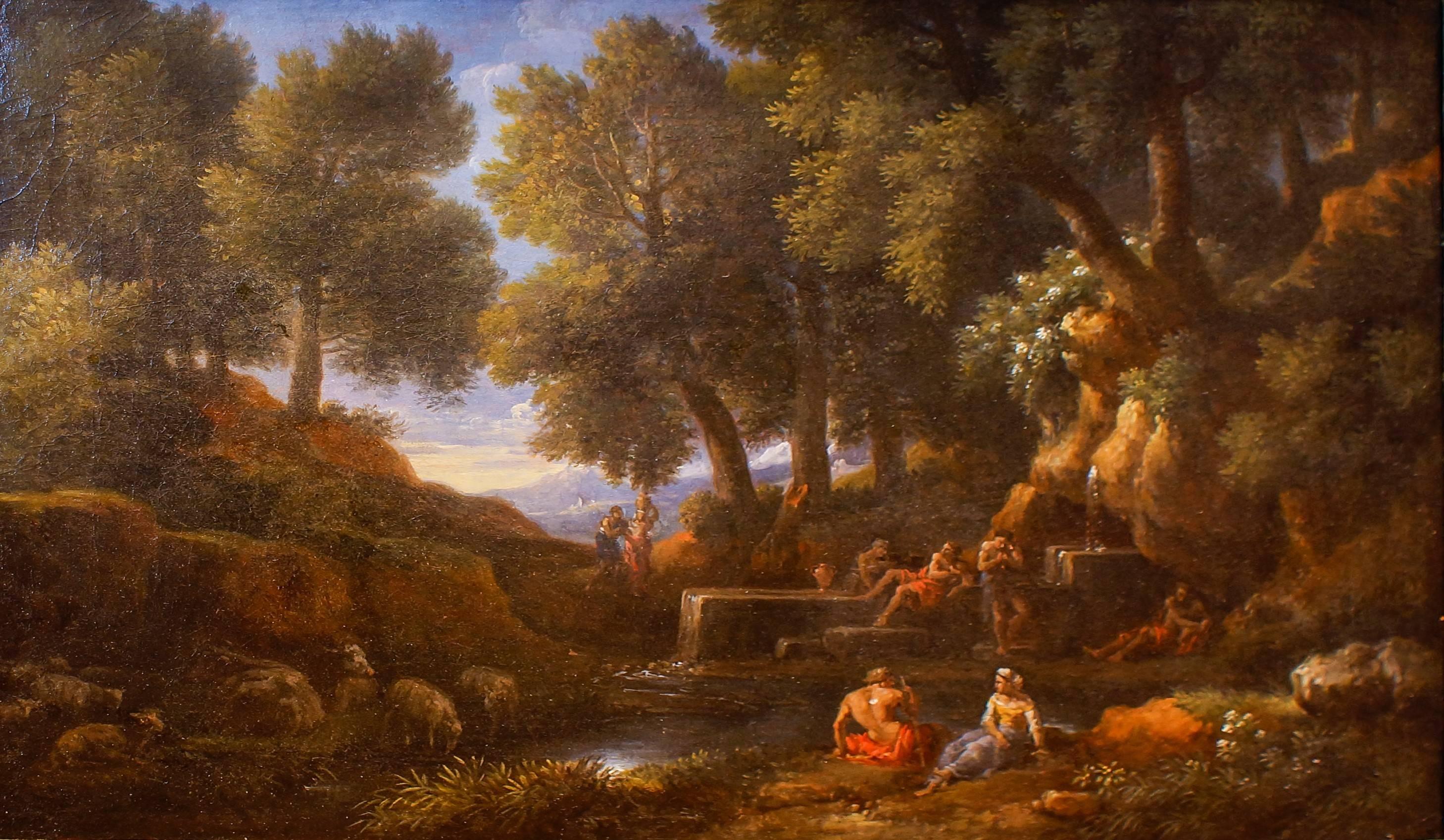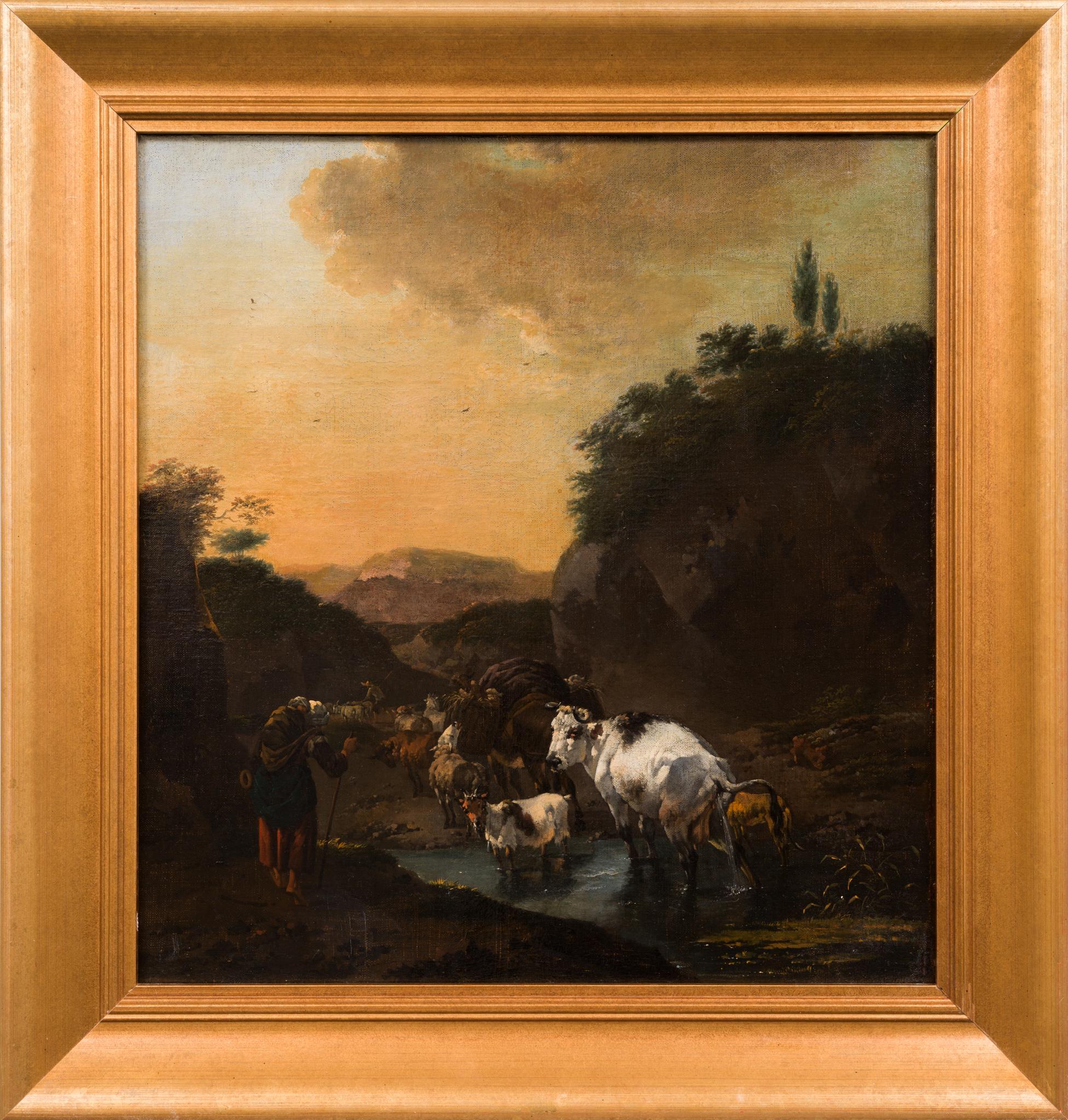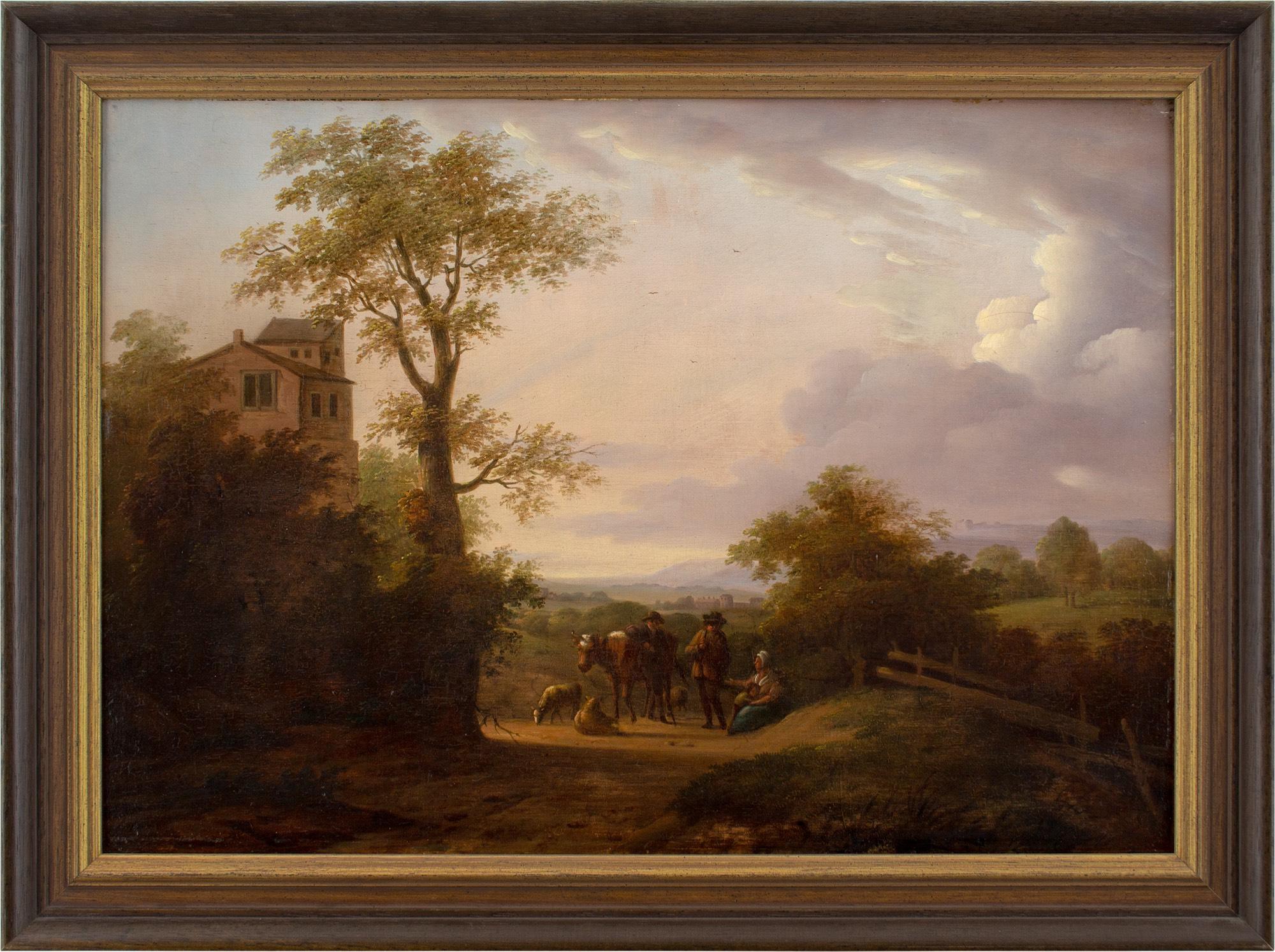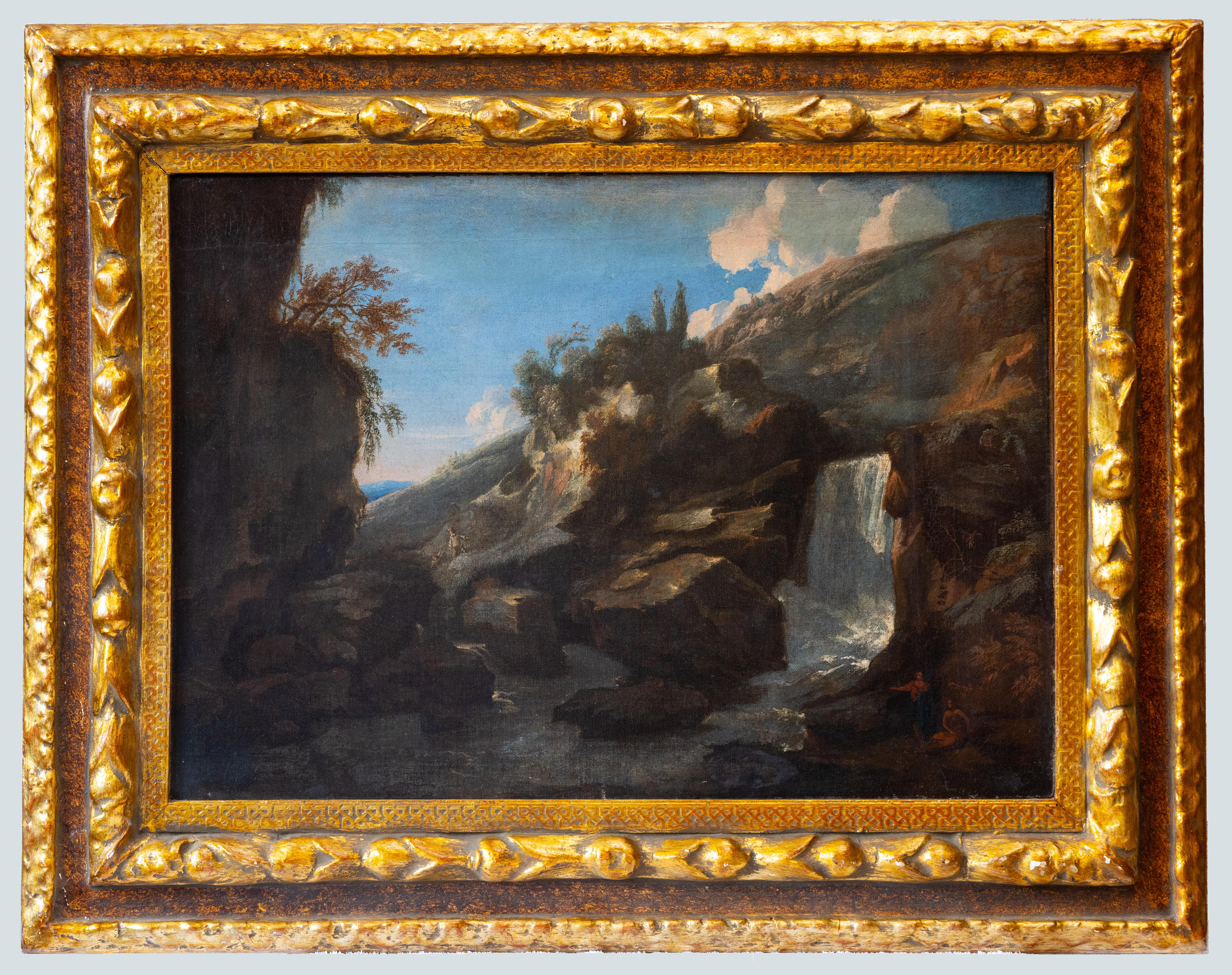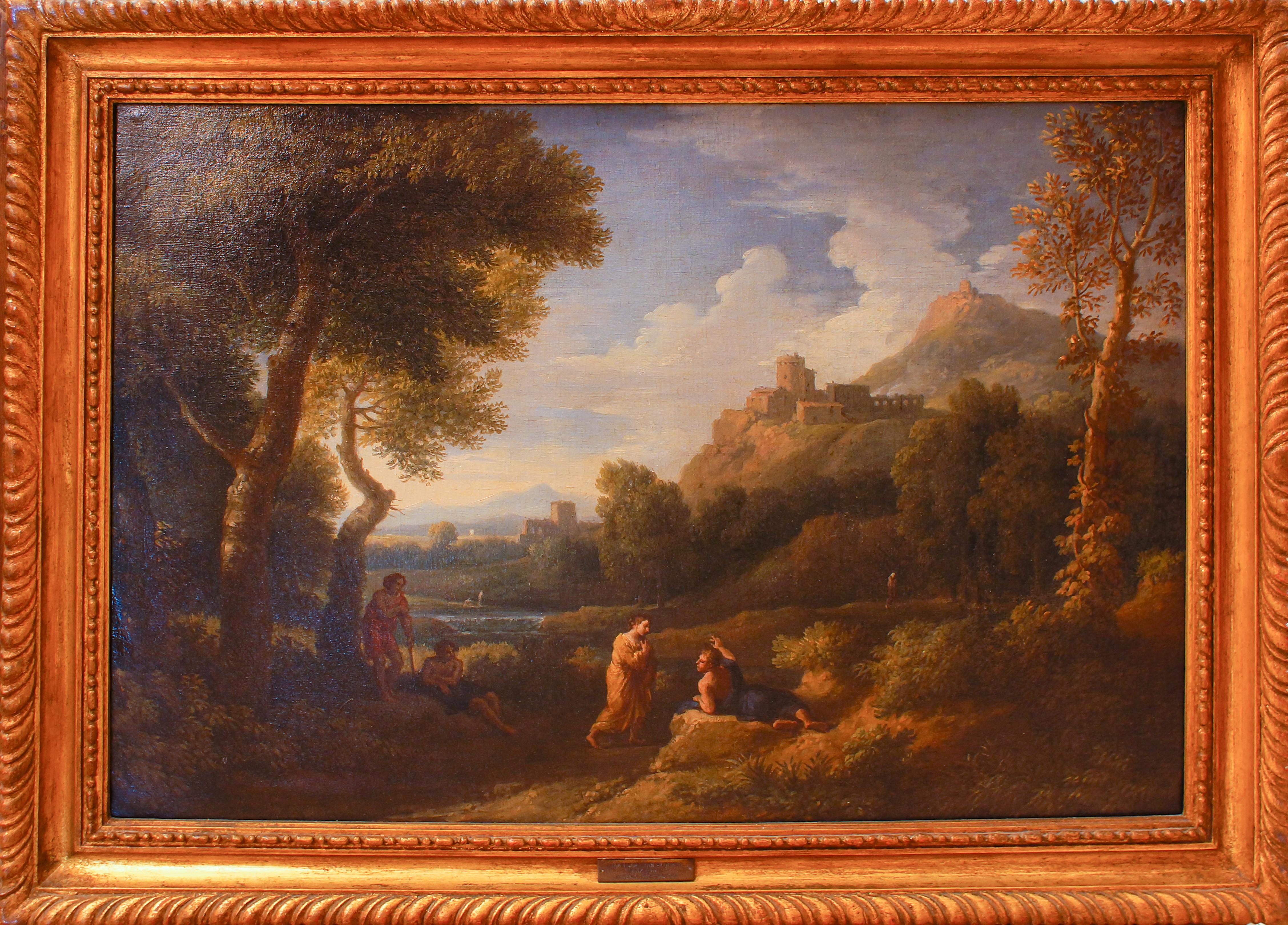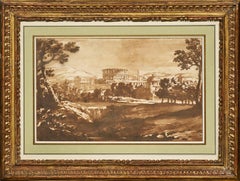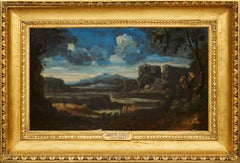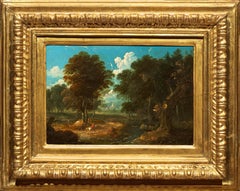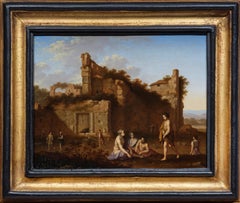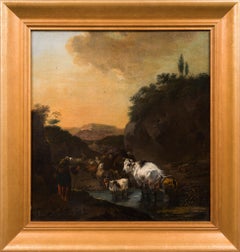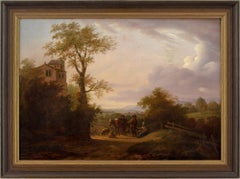Items Similar to River Landscape with Shepherds and Architecture, a painting by Jan van Bunnik
Want more images or videos?
Request additional images or videos from the seller
1 of 9
Jan van BunnikRiver Landscape with Shepherds and Architecture, a painting by Jan van BunnikLate 17th century
Late 17th century
$11,582.08
£8,608.80
€9,750
CA$16,076.57
A$18,034.86
CHF 9,324.56
MX$217,510.40
NOK 118,627.93
SEK 111,106.32
DKK 74,223.26
About the Item
This painting has been the subject of a study by the art historian Fabrizio Dassie (available on request), confirming its inclusion in Jan van Bunnik’s corpus.
In this painting, Jan van Bunnik presents us with an Italian-inspired landscape. Executed with extreme meticulousness, it displays a vast horizon despite the small size of the copper. The double rainbow in the distance also evokes the Flemish landscape tradition.
1. Jan van Bunnik, a Dutch painter in Rome
Born in Utrecht in 1654, from 1668 for a period of three years, Jan van Bunnik (whose family name is also sometimes written van Bunnick) was a pupil of Herman Safleven (1632 - 1685), who had a lasting influence on his work. He then moved to the Duchy of Kleve where he met the painter Gerard Hoet (1648 - 1733) who is said to have convinced him to go to Rome. Once in Rome, he was welcomed by the Nederlandsche Schildersbent (the “painters’ band” an informal association of Netherlandish painters active in Rome during the 17th century). While developing a very personal style, he was obviously influenced by the other Flemish and Dutch landscape painters then present in Rome. He also benefited from the advice of Carlo Maratta, who encouraged him to explore Italianate landscapes.
He then prolonged his stay in Italy, going back and forth between Rome and other artistic centres (Naples, Bologna, Ferrara, Venice, Modena, where he stayed for eight years at the court of Duke Francis II of Este), before returning to Utrecht for the end of his life, after a long journey through France.
Celebrated in the 18th century, he had gradually fallen into oblivion until art historians set out to reconstruct his corpus, separating his artworks from those of Alessandro Grevenbroek (who died in 1748) with whom they were often confused.
2. Description of the artwork
This painting is typical of the fusion between the Flemish tradition of extremely meticulous copper painting and the discovery of Italian light.
In a setting that could evoke the Alban Hills, south-west of Rome, a landscape opens onto an undulating foreground. Various characters appear in the foreground, all facing us: a rider takes his horse to drink from a stream at the foot of a fortified house, a shepherd is accompanying his flock. A lake can be seen in the distance, and at the edge of this lake a first city, followed by a second town on the horizon.
As Fabrizio Dassie explains in his study, the work is typical of the painter's style, reconciling vast atmospheric horizons with a meticulous representation of the smallest details of trees, architecture and characters.
As another example, it is worth mentioning an oil on canvas of a slightly smaller size (13x17 cm), representing a landscape at sunset, sold at Sotheby's on 17 June 2015 (lot 70).
The dark atmosphere, which might suggest a warm late afternoon, allows us to observe an unusual natural phenomenon, the appearance of a double rainbow. This detail evokes other earlier Flemish works, such as Rubens' Rainbow Landscape in the Hermitage Museum (St. Petersburg, Russia - 4th photo in the gallery) or Herman Saftleven's Rainbow River Landscape in the Alte Pinakothek in Munich, Germany (last photo in the gallery).
This painting has been framed with a black frame in the Dutch style.
- Creator:Jan van Bunnik (1654 - 1727, Dutch)
- Creation Year:Late 17th century
- Dimensions:Height: 10.25 in (26.04 cm)Width: 13 in (33.02 cm)
- Medium:
- Movement & Style:
- Period:Late 17th Century
- Condition:5 5/8” x 8 ½” (14.4 x 21.2 cm) – framed : 10 ¼” x 13” (26 x 33 cm).
- Gallery Location:PARIS, FR
- Reference Number:1stDibs: LU1568213467972
About the Seller
5.0
Vetted Professional Seller
Every seller passes strict standards for authenticity and reliability
Established in 2020
1stDibs seller since 2021
10 sales on 1stDibs
Typical response time: 2 hours
- ShippingRetrieving quote...Shipping from: PARIS, France
- Return Policy
Authenticity Guarantee
In the unlikely event there’s an issue with an item’s authenticity, contact us within 1 year for a full refund. DetailsMoney-Back Guarantee
If your item is not as described, is damaged in transit, or does not arrive, contact us within 7 days for a full refund. Details24-Hour Cancellation
You have a 24-hour grace period in which to reconsider your purchase, with no questions asked.Vetted Professional Sellers
Our world-class sellers must adhere to strict standards for service and quality, maintaining the integrity of our listings.Price-Match Guarantee
If you find that a seller listed the same item for a lower price elsewhere, we’ll match it.Trusted Global Delivery
Our best-in-class carrier network provides specialized shipping options worldwide, including custom delivery.More From This Seller
View AllView of an Antique City, a wash landscape by Jan de Bisschop (1628 - 1671)
Located in PARIS, FR
The attribution to Jan de Bisschop has been confirmed by the RKD with the following comment: "We base this attribution on the dark washes, the subject represented and the monogram".
...
Category
17th Century Old Masters Landscape Drawings and Watercolors
Materials
Ink, Pen
Italian Landscape with Jack Players, a painting by Gaspard Dughet (1615 - 1675)
By Gaspard Dughet
Located in PARIS, FR
Here Gaspard Dughet offers us an idyllic vision of the Roman countryside. The stages follow one another in a perfectly structured composition, revealing here a lake, there travellers walking along, gradually leading our eye to the blue horizon. But behind its classical composition, this landscape is particularly interesting because of three anthropomorphic details that the artist has hidden, opening the way to a radically different interpretation...
1. Gaspard Dughet, a landscape artist in the light of Poussin
Gaspard Dughet was born on June 4th, 1615 in Rome where his father, of French origin, was a pastry cook. He was probably named Gaspard in honour of his godfather Baron Gaspard de Morant, who was, or may have been, his father's employer. His older sister Jeanne married the painter Nicolas Poussin (1594 - 1655) on September 1st, 1630. The young Gaspard was apprenticed with his brother-in-law at the beginning of 1631, which led his entourage to name him Gaspard Poussin. The first preserved works of the painter date from the years 1633-1634 and were painted in Poussin’s studio.
Around 1635, Gaspard Dughet became emancipated and began to frequent the Bamboccianti circle. In 1636, he became friends with the painter Jean Miel (1599 - 1656), but also with Pier Francesco Mola (1612 - 1666) and Pietro da Cortona (1596 - 1669).
This was also the time of his first trips throughout Italy. The painter, although of French origin, appears never to have visited France. In 1646 he settled permanently in Rome. A recognized painter with a solid book of orders, he remained faithful to landscape painting throughout his life, alternating between cabinet paintings and large decorative commissions, using both oil and fresco.
Nailed to his bed by rheumatic fever at the age of 58, he died on May 25, 1675.
2. Discovering an idealized landscape
Beyond a relatively dark foreground that takes us into the landscape, we discover a vast bluish horizon: a plateau surrounded by deep ravines advances to the right, overhanging an expanse of water that sparkles below. A road winds through a mountainous mass as if leading us to the fortress that crowns it; another town appears in the distance at the foot of three conical mountains.
The composition is rigorous, mineral, and structured by geometric volumes. The various stages in the landscape lead one to the next attracting the eye towards the horizon located in the middle of the canvas. The general impression is that of a welcoming and serene nature.
In many places the paint layer has shrunk, or become transparent, revealing the dark red preparation with which the canvas was covered and accentuating the contrasts.
Human presence is limited to three jack players, leaning against a mound in the foreground. Their long garments, which may evoke Roman togas, contribute to the timelessness of the scene.
Close examination of the canvas reveals two other travellers on the path winding between the rocks. Made tiny by the distance, their introduction in the middle register, typical of Dughet's art, lengthens the perspective.
While it is difficult to date the work of a painter who devoted his entire life to the representation of landscapes, it is certain that this painting is a work from his later years. The trees that occupied the foreground of his youthful compositions have been relegated to the sides, a stretch of water separates us from the arid mountains counterbalanced by two trees represented on the opposite bank. The introduction of this stretch of water in the middle of the landscape betrays the influence of the Bolognese and in particular of the Dominiquin (1581 - 1641)
A number of similarities with a drawing in the British Museum might suggest a date around 1656-1657, since, according to Marie-Nicole Boisclair , it has been compared with the Prado's Landscape with the Repentant Magdalene, painted at that period.
3. Three amazing anthropomorphic details
While some late Renaissance landscapes offer a radical double reading, allowing one to see both a face or a human body behind the representation of a landscape, it seems interesting to us to hypothesize that Gaspard Dughet had fun here by slipping in a few details that, taken in isolation, evoke human or animal figures.
We will give three examples, looking closely at a cloud, the trunk of a broken tree and the top of a cliff.
The main cloud could thus evoke a Christ-like face or that of an antique god...
Category
1650s Old Masters Landscape Paintings
Materials
Oil
Stag Hunting in the Vicinity of Nuremberg by a German Artist Peter von Bemmel
Located in PARIS, FR
This small landscape shows a hunting scene: two riders are chasing a stag with their dogs at the edge of a forest. Signed by Peter von Bemmel, it is typical of the production of this...
Category
1720s Old Masters Landscape Paintings
Materials
Copper
Gathering in antique Ruins, a monogrammed painting by Jan van Haensbergen
By Jan Van Haensbergen
Located in PARIS, FR
Jan van Haensbergen was a painter of the Dutch Golden Age and a pupil of Cornelius van Poelenburgh (Utrecht 1594 - 1667). The painting we are presenting is inspired by Poelenburgh’s landscapes from his Italian sojourn. The dreamlike atmosphere of this Gathering in antique ruins appealed to us. Against a backdrop of antique ruins, three draped characters (perhaps bathers) are sitting in a circle, greeting a fourth character walking towards them.
Their tranquility contrasts with the bustle of the other characters in the background. They constitute a vivid illustration of otium, this leisure time that allows us to realize our full potential. With this Arcadian landscape, Jan van Haensbergen invites us in turn to leave the hustle and bustle of everyday life behind, to take a break, to enjoy the present moment chatting with close friends…
1. Jan van Haensbergen, a landscape and portrait painter of the Dutch Golden Age
Jan van Haensbergen was born in 1642 in Gorinchem, a town in southern Holland to the east of Rotterdam. He was a pupil of Cornelius van Poelenburgh, and began by painting landscapes inspired by those of his master, in an Italianate style. Between 1668 and 1669, he was registered at the Guild of Saint Luke in Utrecht.
In 1669, he moved to The Hague, where he joined the Confrérie Pictura, an artist society founded in 1656. His portraits, which became his main activity as a painter after settling in The Hague, were strongly influenced by Caspar Netscher (Prague or Heidelberg 1639 - The Hague 1684), whom he met in The Hague and whose son Constantijn became his son-in-law by marrying his daughter Magdalena.
In addition to his work as an artist, Van Haensbergen was also an art dealer, probably helped by his appointment as Dean of the Confrérie Pictura, where he also teached.
2. Description of the artwork and related paintings
This painting seems to us to be a kind of allegory of otium, that quiet bliss promised by Epicurus. It might even evoke an Epicurean proverb: "It is better to lie on the naked ground and be at ease, than to have a golden carriage and a rich table and be worried" .
Three draped young people - two men and a woman in the background - are seated in a circle, greeting a fourth figure walking towards them, hair disheveled and body draped in a towel as if drying off after a bath, indicating the need for prior purification to fully enjoy this rest. Their nonchalance contrasts with the bustle of the various characters in the background.
The composition is punctuated by successive diagonals, and opens onto a landscape on the right, with a succession of mountainous planes. This painting is typical of the Italianate works produced by Van Haensbergen in the 1660s under the influence of Cornelis van Poelenburgh...
Category
17th Century Old Masters Landscape Paintings
Materials
Oak, Oil
Landscape with Trees and a Fisherman walking, a drawing by Jan Van Goyen
By Jan Josefsz Van Goyen
Located in PARIS, FR
No Dutch draughtsman ever captured the atmosphere of the rural countryside of Holland with the same atmospheric and engaging simplicity that Van Goyen achieved in drawings such as this. Indeed, his landscapes were seminal in the development of the genre. The present sketch conveys a striking sense of movement within the natural landscape, conveyed by the deftly applied strokes of chalk, from which the artist’s hand can be sensed. The composition is characteristic of his work, with the low horizon affording significance to the broad sky and the soaring birds within. This feeling of windswept motion powerfully evokes the expansive Dutch farmland with which he was evidently preoccupied.
1. Jan van Goyen...
Category
1650s Old Masters Landscape Drawings and Watercolors
Materials
Chalk, Ink, Laid Paper
Rocky Landscape with Trees and Temple Ruins a drawing by Giulio Parigi (ca 1615)
Located in PARIS, FR
This Rocky Landscape with Trees and the Ruins of a Temple is a drawing by Giulio Parigi, an eclectic and prolific artist of the Medici court. An engraver, architect, furniture and je...
Category
1610s Old Masters Landscape Drawings and Watercolors
Materials
Ink, Laid Paper, Pen
You May Also Like
Wooded Figurative River Landscape - Dutch 17thC Golden Age art oil painting
Located in Hagley, England
This superb 17th century Dutch Golden Age oil painting has been more recently reattributed to Abraham Begeyn by Dr Marijke C. de Kinkelder formerly of the RKD - Netherlands Institute for Art History. Painted circa 1640 it is an Italianate wooded river landscape with drovers and their herd crossing a river with a watchtower beyond. Begeyn was one of the many 17th-century Dutch and Flemish painters to embrace the Italianate style, populating their decidedly non-Dutch, mountainous landscapes with rustic travellers and picturesque ruins bathed in warm, Mediterranean light. It has Begeyn's characteristic brightly lit cattle and grouping of figures, similar to a comparable painting in the Lichtenstein Princely Collections. The brushwork and details are superb. One can see the influence of his teacher Nicholaes Berchem (1620-1683) and the typical golden glow of the Golden Age painters. This is a stunning 17th century Golden Age oil painting and an excellent example of Begeyn's work.
Provenance: With Koetser Gallery, Zurich. Private Collection (Rhine region). Anon. sale, Dorotheum, Vienna, 22 June 2010, lot 357, as by Jacob de Heusch (€18,600).
Anon. sale, Christie's South Kensington,18 November 2015, lot 432, as 'Follower of Nicolaes Berchem'; where purchased by the present owner.
Note: Begeyn was one of the many 17th-century Dutch and Flemish painters to embrace the Italianate style, populating their decidedly non-Dutch, mountainous landscapes with rustic travellers and picturesque ruins bathed in warm, Mediterranean light.
He is thought to have studied under Nicolaes Berchem (1620-1683), a pioneer of this genre of landscape painting, and travelled extensively to Italy, London and later to Germany in 1688, where he lived out his days as court painter to Frederick III, Elector of Brandenburg (later Frederick I, King of Prussia).
The present work was previously thought to be the work of Jacob de Heusch (1656-1701), but has been more recently reattributed to Abraham Begeyn by Dr Marijke C. de Kinkelder formerly of the RKD - Netherlands Institute for Art History.
A comparable scene, which also includes Begeyn's characteristic brightly lit cattle and a similar figure group, was sold at Christie's Amsterdam, 18 November 2015, lot 110. Another can be found in the Liechtenstein Princely Collections (no.GE 290).
Condition. Oil on canvas, image size 21 inches by 18 inches and in good condition.
Frame. Housed in a beautiful gilt frame, 28 inches by 25 inches and in good condition.
Abraham Begeyn (c. 1637 Leiden - 11 June 1697 Berlin), was a Dutch Golden Age painter. Begeyn was born in Leiden. Though perhaps known mostly for his Italianate landscapes and cattle in the manner of Nicolaes Pietersz Berchem, Begyn was a highly skilled painter active in many genres, who travelled widely. According to the RKD, Begeyn's earliest known work is from 1653, though he was first accepted into the Guild of St. Luke in Leiden in 1655. He stopped paying dues in 1667, because he set off for a trip to Italy. He is registered in Rome and Naples from 1659–1660. In the rampjaar or disaster year, of 1672, he is registered in Amsterdam, and after that he lived in London, where he painted at Ham House, Surrey, together with Willem van de Velde the Younger (1633–1707) and Dirck van Bergen...
Category
1640s Old Masters Landscape Paintings
Materials
Oil
Wooden Landscape with Shepherds, Fountain and Flock - by Jan Frans van Bloemen
By Jan Frans van Bloemen (Orizzonte)
Located in Roma, IT
Bibliography:
A.Busiri Vici, Jan Frans Van Bloemen Orizzonte e l’origine del paesaggio romano settecentesco, Ugo Bozzi Editore, Roma 1974, n.41
This artwork is shipped from Italy. U...
Category
18th Century Old Masters Landscape Paintings
Materials
Canvas, Oil
Shepherd with Sheep, Cows and a Goat in a Landscape by Jan Frans Soolmaker
Located in Stockholm, SE
This painting depicts a pastoral scene that is attributed to the artist Jan Frans Soolmaker, an artist known for his Italianate landscapes and scenes that often feature equestrian and Arcadian elements. The painting is not signed but is attributed to Soolmaker, relating it to a known signed work by the artist that was sold at Sotheby’s London in 1999.
The scene is suffused with the warm glow of a setting or rising sun, casting a soft light that is characteristic of Soolmaker’s landscapes. It shows a shepherd guiding a group of cattle across a shallow stream, with the animals taking center stage in the composition. The animals are rendered with careful attention to their forms and the play of light on their bodies, which is a hallmark of Soolmaker's work. The landscape is composed of a rocky terrain with trees and shrubbery, creating a sense of depth and natural beauty that invites the viewer to explore the scene further.
The background suggests a vast, open landscape with distant mountains, which adds to the Italianate feel of the painting. The sky is dramatic, with clouds catching the light of the sun, contributing to the overall serene yet dynamic atmosphere of the work.
The provenance of the painting is notable, having been in the possession of significant historical figures such as Swedish Prince Fredrik Adolf, and later The collection of Pär Ulmgren, The collection of Gösta Stenman, and Engineer and politician Gustaf Henry Hansson.
Potential buyers have the option of choosing between a newly made gold frame or an older brown frame, which allows for personalization in how the work is presented.
Soolmaker’s work is often compared to that of Dutch painter Nicolaes Berchem, whose style he emulated. Soolmaker's landscapes reflect a similar sensitivity to light and composition, making his works sought after for their beauty and historical significance. Despite the smaller body of work left by Soolmaker, due to his short career, his paintings are valued for their craftsmanship and the legacy of the artist’s brief but impactful contribution to the Dutch Italianate landscape genre.
Information:
Jan Frans Soolmaker (Flanders 1635‑1685)
Shepherd with Sheep...
Category
17th Century Old Masters Animal Paintings
Materials
Canvas, Oil
$4,271 Sale Price
20% Off
Mid-18th-Century Dutch School Landscape With Travellers, Distant View & Building
Located in Cheltenham, GB
This splendid mid-18th-century Dutch landscape painting depicts a view with travellers before distant rolling hills.
Amid the long shadows of early evening, a travelling party rests...
Category
1750s Dutch School Landscape Paintings
Materials
Wood Panel, Oil
Landscape with waterfall, Dutch School 17th century
Located in GB
This dramatic landscape, attributed to the 17th-century Dutch School, exemplifies the Baroque fascination with nature’s grandeur and theatrical contrasts. The composition features a ...
Category
17th Century Landscape Paintings
Materials
Canvas, Oil
Pair of Roman Landscapes - by J.F. Van Bloemen - 18th Century
By Jan Frans van Bloemen (Orizzonte)
Located in Roma, IT
Beautiful couple of Roman Landscape by J. F. Van Bloemen, in very good conditions and with later wooden frames.
Bibliography and Exhibitions:
Old Master Exhibition, H.Terry-Engell, ...
Category
Early 18th Century Landscape Paintings
Materials
Oil, Canvas
More Ways To Browse
18th Century French Landscape
Antique Copper Painting
17th Century Dutch Landscape
Rainbow Landscape
Old Masters Paintings Of Venice
Dutch Landscape Oil Painting Small
17th Century Italian Landscape
Horse Painting Old Masters
17th Century Dutch Landscape Paintings
18th Century Italian Landscape Painting
Painting Dutch Town
Dutch Oil Painting River
German Shepherd
German Shepherds
Shepherd And Flock
Flemish 18th Century Oil Painting
German Shepherd Antique
Antique Copper Horse

